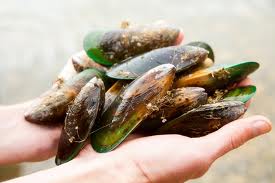SUMMARY
Green-lipped mussel has pain relieving properties and been shown to reduce pain intensity and increase the mobility of knee joints in patients with osteoarthritis. Significantly, it supports better intestinal health, because it is better digestible than many other conventional treatments.
The symptoms of osteoarthritis can be improved by supplementation with glucosamine and green-lipped mussels.
How green-lipped mussel is used to treat osteoarthritis
Lower risk alternatives to the conventionally used non-steroidal analgesics (pain relief drugs with agents such as ibuprofen) are in demand by patients with arthritic conditions. Green-lipped mussel has been a popular remedy and is also often taken preventively.
Scientific studies have now found the first evidence that the green lipped mussel can actually help with pain and joint damage as a result of osteoarthritis.
The green-lipped mussel (Perna canaliculus) owes its name to the greenish shiny hem at its two shells. It is found only in the waters off New Zealand and is highly protected.
Today, tens of thousands of tons of green-lipped mussels are commercially farmed and harvested annually. They are often freeze-dried as extracts and exported overseas.
Due to the high concentration of betain, iron and glycoaminoglycans (including chondroitin sulphate) green-lipped mussels are widely used in treatments for arthritic joint diseases. So is there scientific evidence to support the use of green-lipped mussel extracts as actually helping osteoarthritis?
Two meta-studies of green-lipped mussel
Meta-studies have several advantages over single studies as they can eliminate random factors that can distort results. In 2008, Brien and colleagues evaluated studies on the use of green-lipped mussel1. They concluded that the green lipped mussel is likely to have a beneficial effect in mild to moderately advanced osteoarthritis. However, at that time, further studies were needed to confirm these observations.
A 2012 published study from Australia confirmed the assumption of Brien and colleagues. Green-lipped mussels reduced pain intensity and increased the mobility of the affected knee joints in patients with osteoarthritis2.
In addition, the Australian researchers were able to show that existing gastrointestinal problems significantly improved. Digestive problems are a common side effect for patients that rely on conventional painkillers. Similar results were observed in a follow-up study one year later. This research suggests that the symptoms of osteoarthritis can be improved by supplementation with glucosamine and green-lipped mussels, plus support better intestinal health3.

Green-lipped mussel: effects on joints of animals
One of the biggest criticisms of the handling of green-lipped mussels in studies is that a placebo effect cannot always be ruled out entirely. But there are other studies that have examined green-lipped mussel and their effects on animals.
Since animals do not exhibit placebo effects, the observed results can be considered more conclusive.
Study in dogs with joint problems
Degenerative joint disease and arthritis are common in dogs and horses. As early as 2006, a study on dogs showed that green-lipped mussels can alleviate suffering from degenerative joint disease4.
Eighty-one dogs were given a dose of green-lipped mussel or a placebo as a control for 56 days. A study of muscles and joints was made in all animals by a veterinarian. During the first 28 days, no differences between animals of the two groups were observed. When re-evaluated after 56 days, the symptoms improved in dogs supplemented with green-lipped mussels compared with the placebo group.
The researchers concluded that green-lipped mussel is helpful in mild joint degeneration. Yet, it may require a long-term supplementation to support a noticeable improvement of symptoms.
Study on green-lipped mussel in horses
A similar scale study on lame horses also demonstrated the efficacy of green-lipped mussel in relation to pain and inflammation caused by degenerative joint disease5.
The anti-inflammatory effects of green-lipped mussel has also been demonstrated in rats6. Green-lipped mussel contains a rare form of fatty acids, the so-called F-furanoid fatty acids. These have antioxidant properties and are probably the cause the observed inhibition of inflammation in the studies.
Tips for purchasing green-lipped mussel supplements
If you want to buy the extract of the New Zealand mussel, you should make sure that the capsules are individually blister packed. Unfortunately, this is not the case for about 95% of products.
Therefore, you usually have to take a strong-smelling fishy odour supplement packaged in loose caps.
Bibliography
- Brien et al., 2008. Systematic review of the nutritional supplement Perna canaliculus (green-lipped mussel) in the treatment of osteoarthritis. QJ Med 101, 167-179
- Coulson et al., 2012. Green-lipped mussel (Perna canaliculus) extract efficacy in knee osteoarthritis and improvement in gastrointestinal dysfunction: a pilot study. Inflammopharmacology 20 (2), 71-6; doi: 10.1007/s10787-012-0128-6
- Coulson et al., 2013. Green-lipped mussel extract (Perna canaliculus) and glucosamine sulphate in patients with knee osteoarthritis: therapeutic efficacy and effects on gastrointestinal microbiota profiles. Inflammopharmacology 21 (1), 79-90. doi: 10.1007/s10787-012-0146-4.
- Pollard et al., 2006. Clinical efficacy and tolerance of an extract of green-lipped mussel (Perna canaliculus) in dogs presumptively Diagnosed with degenerative joint disease. NZ Vet J 54 (3), 114-8.
- Cayzer et al., 2012. A randomized, double-blinded, placebo-controlled study on the efficacy of a unique extract of green-lipped mussel (Perna canaliculus) in horses with chronic fetlock lameness attributed to osteoarthritis. Equine Vet J 44 (4), 393-8; doi: 10.1111/j.2042-3306.2011.00455.x.
- Wakimoto et al., 2011. Furan fatty acid as in anti-inflammatory component from the green-lipped mussel Perna canaliculus. PNAS 108 (42), 17533-17537.






